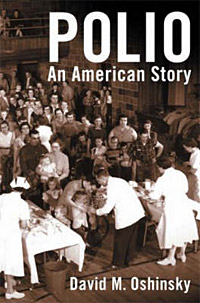 | |
| Author | David M. Oshinsky |
|---|---|
| Genre | Non-fiction |
| Publisher | Oxford University Press |
Publication date | 2005 |
| Pages | 342 |
| ISBN | 0-19-515294-8 |
Polio: An American Story by David M. Oshinsky, professor of history at the University of Texas at Austin, documents the polio epidemic in the United States during the 1940s and 1950s and the race to develop a vaccine, which led to 2 different types of polio vaccine: inactivated poliovirus vaccine, developed by a team led by Jonas Salk, and oral poliovirus vaccine, developed by a team led by Albert Sabin.
Contents
Published in 2005 by the Oxford University Press, it won the 2006 Pulitzer Prize for History and the 2005 Herbert Hoover Book Award.

